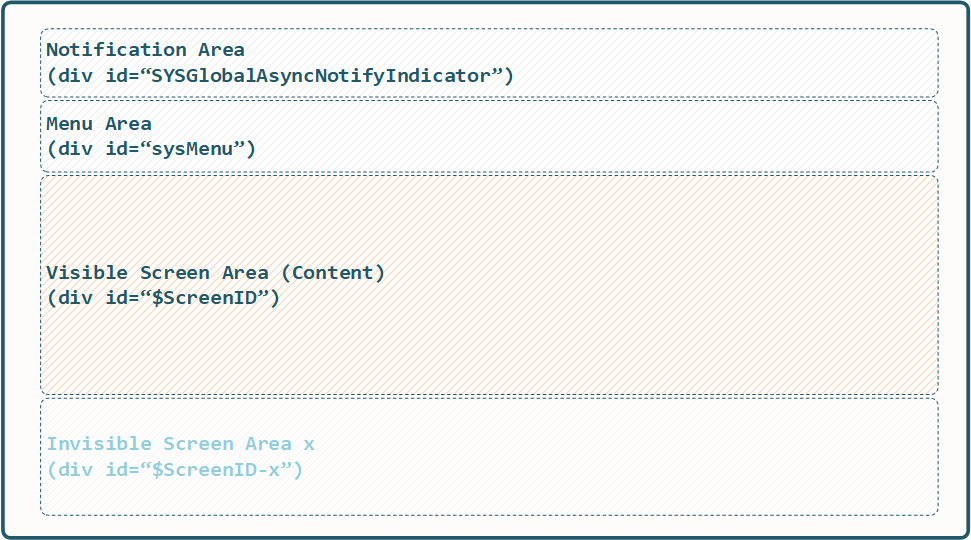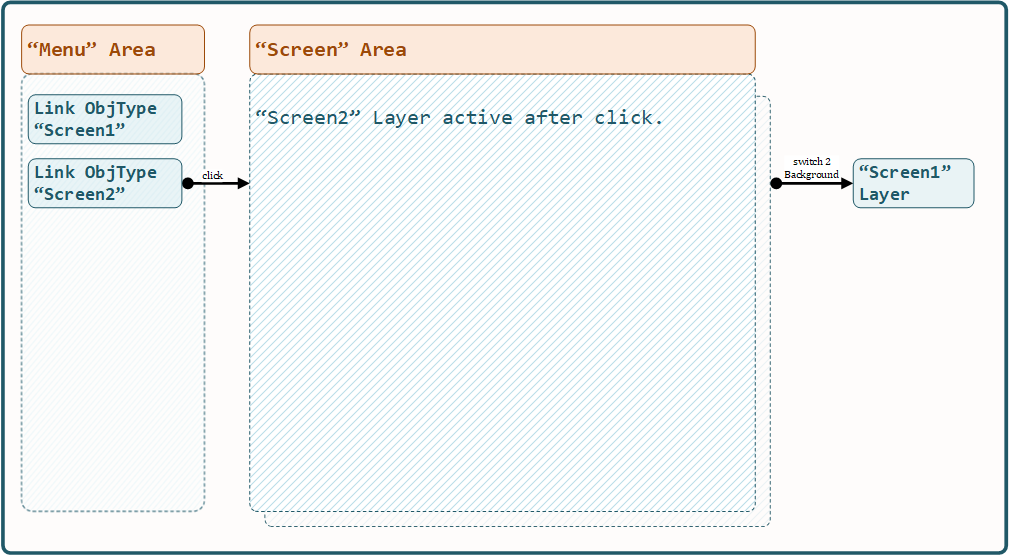7. Basic Configuration
Unlock the power of x0! This section guides you through setting up your SPA with clear, modular, and scalable configurations.
7.1. Browser Content Areas
The x0-framework features a modern, three-pane layout:
Menu Area – Navigation and commands (DOM id:
sysMenu)Screen Content Area – Main display for app content
Notification Area – Real-time app and status messages

Browser Content Areas
💡 Tip: Invisible screen layers work behind the scenes for seamless transitions.
7.1.2. Screen Area
The main stage for your content.
default_screenis set via config (see: System Config).UI structure and object relationships are defined in
skeleton.json.CSS (e.g., Bootstrap Grid) controls layout.

Screen Switch
7.1.3. Notification Area
Displays status info from backend/web service calls.
Flexible CSS positioning.
7.1.4. Object State Preservation
x0 guarantees 100% state preservation—switch screens, tabs, or navigate, and every object stays exactly as you left it.
Example #15 - Tree Simple demonstrates:
https://download.webcodex.de/x0/video/x0-example-15-tree-simple.mkv
7.1.5. Area Positioning / CSS
Uses Bootstrap Grid for simple, responsive layouts.
Example:
<body class="row">, withcol-md-xclasses for areas.Menu defaults to
position: absolute, but fully customizable.See Bootstrap Grid Docs.
✨ Modern CSS and Bootstrap make layout effortless!
7.2. Database Configuration
x0-application config data lives in the system.config and
webui.text tables.
SQL scripts must be in
/database.Database updates occur during Docker image builds.
7.2.1. System Configuration
Key config parameters (in system.config):
Parameter |
Type |
Description |
|---|---|---|
index_title |
String |
Page title |
debug_level |
Integer |
Debug level |
display_language |
‘en’ | ‘de’ |
UI language |
default_screen |
String |
Default screen ID |
parent_window_url |
String (URL) |
Parent (WP) plugin URL |
subdir |
String (Path) |
Static backend path |
message_handler |
Boolean |
Enable (true) msg handling |
config_file_menu |
String |
Menu config filename |
config_file_object |
String |
Object config filename |
config_file_skeleton |
String |
Skeleton config filename |
Default insert example:
INSERT INTO system.config (config_group, "value") VALUES ('index_title', 'x0 Default App');
7.2.2. Display Text
Multi-language text in
webui.text.Reference these IDs in your JSON configs.
INSERT INTO webui.text (id, "group", value_en, value_de)
VALUES ('TXT.TEXTID.1', 'group1', 'English Text #1', 'German Text #1');
7.2.3. Application ID
Append
?appid=example2to your app URL to load another config set!Store separate config rows for each
app_id.
7.7. Application Server Config (app-config.json)
Define in /config/app-config.json:
Database auth
Virtual hosts
x0-applications
⚠️ Multi-virtual-host and environment support requires proper database config and packaging. Not available in standalone/Docker.
7.7.1. Database Authentication
Users created automatically during Docker build:
postgres(su_password)x0(x0_password)replication(repl_password)
7.7.2. Virtual Hosts
Apache virtual hosts are generated per JSON config during Docker builds.
SSL is only fully automated for Kubernetes deploys.
7.7.3. x0-Applications
Multiple apps: Kubernetes only.
7.7.4. Default Config Example
{
"installer": { "type": "x0" },
"database": { "name": "x0", "su_password": "changeme", "x0_password": "changeme" },
"env_list": [ "default" ],
"vhosts": {
"x0-app": {
"apps": [ "x0" ],
"env": {
"default": {
"dns": { "hostname": "x0-app", "domain": "x0.localnet" }
}
}
}
}
}
7.4. Application Metadata & Object Model
x0 uses a declarative, JSON-driven UI/config model:
object.json – All UI objects, attributes, metadata
skeleton.json – How objects/screens are structured and related
menu.json – Menu objects and navigation hierarchy
Workflow: 1. skeleton.json initializes the UI hierarchy. 2.
object.json defines the objects, inserted dynamically. 3.
menu.json creates the menu structure.
Highly modular, scalable, and runtime-flexible!
7.4.1. object.json
Each object:
{
"$ObjectID": {
"Type": "$ObjectType",
"Attributes": {}
}
}
IDs are referenced in
menu.jsonandskeleton.json.
7.4.2. skeleton.json
Defines screens and what objects are on them, e.g.:
{
"Screen1": [
{ "Object1": { "RefID": "Screen1" } }
]
}
7.5. Metadata ElementID
Reference object elements (like tabs) via
ElementIDproperty inskeleton.json.
Example: Tab Container
object.json
{
"TabContainer1": {
"Type": "TabContainer",
"Attributes": {
"Tabs": [
{ "ID": "Tab1", "Default": true, "TextID": "TXT.BASIC-TABCONTAINER.TAB1", "Style": "col-md-4" },
{ "ID": "Tab2", "TextID": "TXT.BASIC-TABCONTAINER.TAB2", "Style": "col-md-8" }
]
}
}
}
skeleton.json
{
"Screen1": [
{ "TabContainer1": { "RefID": "Screen1" } },
{ "Text1": { "RefID": "TabContainer1", "ElementID": "Tab1" } },
{ "Text2": { "RefID": "TabContainer1", "ElementID": "Tab2" } }
]
}
7.6. Object Templates
Add custom object templates via
template_fileandsetup_classconfig parameters in the DB.Place
.jstemplates in/static.
🚀 x0: Modular, Dynamic, and Developer Friendly
With JSON-powered configuration, robust state management, and modern CSS support, x0 is built for serious SPA development—without sacrificing flexibility or performance.